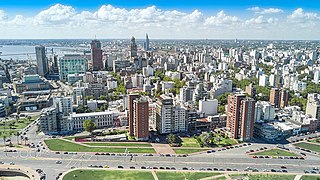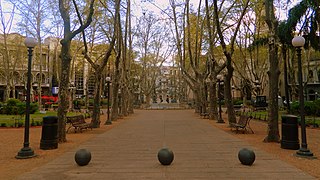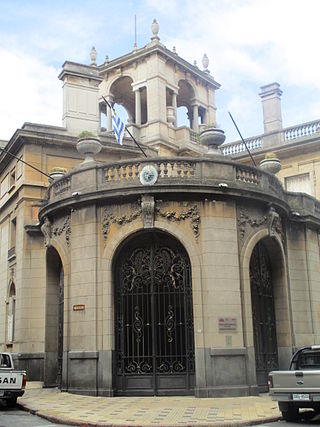
Montevideo is the capital and largest city of Uruguay. According to the 2011 census, the city proper has a population of 1,319,108 in an area of 201 square kilometers (78 sq mi). Montevideo is situated on the southern coast of the country, on the northeastern bank of the Río de la Plata.

Chuy is a city in the extreme east of Uruguay, in the Rocha Department, 340 kilometres (211 mi) northeast of Montevideo. It lies on the border with Brazil, separated from its Brazilian sister town of Chuí only by a shared avenue that serves as the border, and by the Arroyo Chuy (stream) to the east. Chuy's population was 9,675 in 2011.

Brazo Oriental is a barrio of Montevideo, the capital of Uruguay. Brazo Oriental is a residential zone located approximately 5 kilometres (3.1 mi) from Montevideo's centre.

Plaza de la Constitución, also known as Plaza Matriz, is the oldest city square in Montevideo, Uruguay.

Artigas Boulevard is a boulevard in Montevideo, Uruguay. It runs from the Rambla at Punta Carretas to the Rambla at Capurro-Bella Vista, going north for about 6.5 kilometers and turning 100° west. It is an important connection road, linking the central barrios of the city, with access to different national routes.

The Estévez Palace is a building situated in Plaza Independencia, Montevideo, Uruguay, designed in a combination of Doric and Colonial styles by Manoel de Castel in 1873. It has served as the working place of the President of Uruguay and has been eventually converted to a museum, housing artifacts and mementos of the Uruguayan presidency and its office holders.

Juan Manuel Blanes Municipal Museum of the Arts is a museum in Prado, Montevideo, Uruguay.

Luis Alberto Aparicio Alejandro Lacalle Pou is a Uruguayan politician and lawyer serving as President of Uruguay since 1 March 2020.

Luis Alberto de Herrera was a Uruguayan lawyer, diplomat, journalist and politician.

The Museo Nacional de las Culturas is a national museum in Mexico City dedicated to education about the world's cultures, both past and present. It is housed in a colonial-era building that used to be the mint for making coins. Prior to this, the site was the home of the location of the Moctezuma's Black House. The mint was moved to Apartado Street in 1850, and the building was used for various purposes until it was converted to its current use in 1966.

Aires Puros is a barrio of Montevideo, Uruguay.

Palacio Taranco, located in front of the Plaza Zabala, in the heart of the Old City of Montevideo, Uruguay, is a palace erected in the early 20th century during a period in which the architectural style was influenced by French architecture. It was designed by French architects Charles Louis Girault and Jules Chifflot León, who also designed the Petit Palais and the Arc de Triomphe in Paris. This building contains European furniture and drapings and currently contains the Museum of Decorative Arts in Montevideo. The palace is often used as a meeting place by the Uruguayan government.

Parque Prado is the largest of Montevideo's six principal public parks. Established in 1873, it covers an area of 106 hectares and is located in the barrio of Prado. Located in the northern part of the city, the Miguelete Creek flows through the neighbourhood and park of the same name.

Libertador Avenue is a major avenue in Montevideo, Uruguay. It stretches north from the Legislative Palace in Aguada to Plaza Fabini in Centro, and is named after Juan Antonio Lavalleja, revolutionary figure and politician, who led the group of the Thirty-Three Orientals in the insurrection for the independence of Oriental Province.

The German community in Uruguay numbers ca. 15,000 German expatriates and 200,000 people of German descent. Most of them live in the Montevideo area, although there are German minorities in Paysandú, Río Negro, San José and Canelones.

Edmundo Prati was a Uruguayan sculptor.

Museo de la Memoria (MUME) is a museum in Montevideo, Uruguay dedicated to the memory of those or died or were "disappeared" during the Uruguayan dictatorship of 1973 to 1985.


















